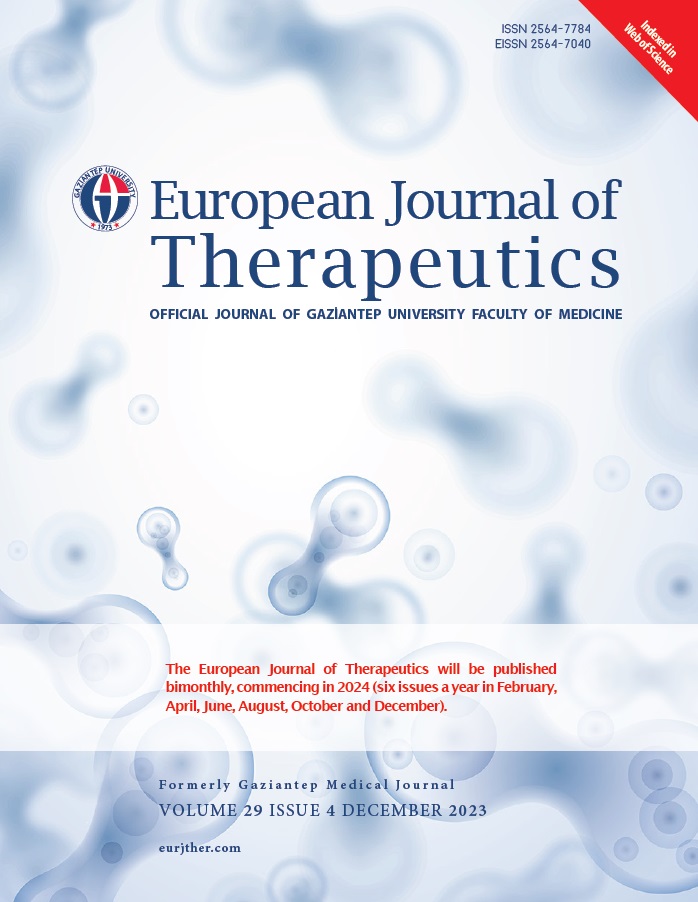Immunoglobulin-G4 Related Disease with Multiple Organ Involvement
DOI:
https://doi.org/10.58600/eurjther1960Keywords:
Immunoglobulin-G4 Related Disease, Heart, Kidney, hypophysis, multiple organ involvementAbstract
Dear Editor,
Immunoglobulin G4-related disease (IgG4-RD) is an immune-mediated fibroinflammatory disease affecting multiple organ systems. The clinical findings may range due to the affected organ. The main distinguishing histopathological features of IgG4-RD are lymphoplasmacytic infiltration, storiform fibrosis, obliterative phlebitis, and mild or moderate tissue eosinophilia. Rarely, it may affect the lungs, hearts, pituitary, meninges, skin, prostate, breast, and thyroid gland [1–3]. In this article, we present a case diagnosed with IgG4-related disease involving multiple organs, including the pituitary, lymphatic system, kidney, and heart, and the patient responded well to immunosuppressive treatment.
A fifty-five-year-old female patient applied with complaints of fatigue, polydipsia, polyuria, widespread body pain, and 20 kg weight loss in the last year. After excluding other possibilities, with a prediagnosis of diabetes insipidus (DI) pituitary MRI was performed which showed an increase in size and heterogeneous patchy contrast enhancement in the adenohypophysis (Fig. 1a). Based on the current clinical and imaging findings, the patient's laboratory results were evaluated, and central DI was diagnosed. In computerized thorax tomography, multiple lymph nodes in the mediastinum were detected, the largest of which was 21x17 mm. Tissue sampling was performed with the guidance of EBUS, pathological examination showed no diagnostic findings. Transesophageal Echocardiography (TEE) revealed an appearance consistent with a 10-15 mm thick thrombus surrounding the left atrium wall and narrowing the cavity. Increased thickness narrowing the left atrial lumen was reported in thorax computed tomography (CT) (Fig. 2). Further, a cardiac MRI was performed and reported to be consistent with lymphoproliferative-inflammatory involvement rather than thrombus. Abdominopelvic CT was performed and a lesion of 54x28 mm in size, less contrast enhancing than the surrounding parenchyma, in the middle part posterior of the left kidney was detected (Fig. 3). Histopathological findings were consistent with inflammatory processes, and no findings in favor of a neoplastic lymphoproliferative process were detected in the samples. Since the patient was presented with pituitary involvement, mediastinal lymphadenopathy, renal and cardiac mass, the IgG4 level was ordered and resulted as 299 mg/dl (3-201). IgG4 staining could not be performed in the current biopsy specimen; for confirming the diagnosis of IgG4-related disease, a re-biopsy was performed on the kidney mass. Histopathological findings were consistent with IGG4-RD (Fig. 4). Due to multisystemic involvement, the patient received 0.6 mg/kg/day oral corticosteroid and mycophenolate mofetil 3x1000 mg/day. The pituitary MRI that was performed in the first month of treatment was normal (Fig. 1b). Desmopressin treatment was stopped. Also, control TEE in the first-month follow-up visit showed a significant reduction in the mass image in the left atrium. After three months of follow-up, there was a significant improvement in the patient's symptoms and acute phase response. The corticosteroid was tapered and maintenance treatment with mycophenolate mofetil was continued.
IgG4-related disease is rare and difficult to diagnose, though its presentation may be in a wide variety of clinical features. It is crucial to make an early diagnosis and start treatment early in these patients to prevent morbidity and mortality. In cases with mass lesions and especially with multiple organ involvement, as in our case, IgG4-related disease should be kept in mind, and IgG4 staining should always be kept in mind.
Kind Regards
Metrics
References
An YQ, Ma N, Liu Y (2022) Immunoglobulin G4-related disease involving multiple systems: A case report. World J Clin Cases. 10:2543–2549. https://doi.org/10.12998/wjcc.v10.i8.2543
Kawa S (2019) Immunoglobulin G4-related Disease: An Overview. JMA J. 2:11–27. https://doi.org/10.31662/jmaj.2018-0017
Wang S, Xu X, Bai Z, Yi F, Wang R, Guo X, Qi X (2020) IgG4-related disease with multiple organs involvement was effectively controlled by glucocorticoids: a case report. AME Case Rep. 4:22. https://doi.org/10.21037/acr-20-43
Downloads
Published
How to Cite
License
Copyright (c) 2023 European Journal of Therapeutics

This work is licensed under a Creative Commons Attribution-NonCommercial 4.0 International License.
The content of this journal is licensed under a Creative Commons Attribution-NonCommercial 4.0 International License.


















